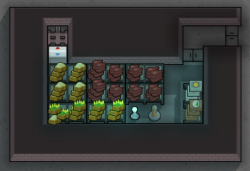Cooler
Cooler
An air-cooling machine that fits into a wall. Cool air comes out one side, while hot exhaust comes out the other. Can be used to cool down rooms during summer, or to create a walk-in freezer.
Base Stats
- Type
- Building – Temperature
- HP
- 100
- Flammability
- 70%
Building
- Size
- 1 × 3
- Placeable
- True
- Cover Effectiveness
- 75%
- Terrain Affordance
- Medium
- Power
- -200 W
Creation
- Required Research
- Air conditioning
- Skill Required
- Construction 5
- Work To Make
- 1,600 ticks (26.67 secs)
The cooler is a device that can be used to lower the temperature in a room by moving the heat to its other side. This effect can maintain happy colonists during high outdoor temperatures, prevent heat stroke and prevent perishable items like food from spoiling. It requires power to operate.
They are the high-tech upgrade to passive coolers, requiring research and power, but not limited to low of 17 °C (62.6 °F) and thus capable of refrigerating or freezing food.
Acquisition
Constructing a cooler requires Air Conditioning to be researched, which New Arrivals start with. It requires ![]() 90 Steel,
90 Steel, ![]() 3 Components and is constructed in 1,600 ticks (26.67 secs).
3 Components and is constructed in 1,600 ticks (26.67 secs).
Summary
Coolers take the place of a wall tile. If powered, they will cool their front side (shown by a blue tile on placement), and conversely, will heat their back side (red tile). The cooler must not be blocked on either side, and rooms must be enclosed with a mostly complete roof in order to actually be cooled/heated. Coolers will attempt to cool the room to its target temperature, though surrounding heat and the room's size may make this impossible. See the temperature page for more details.
Coolers have two states of power consumption: high and low.
- A cooler that is actively cooling consumes 200W (high power).
- If the target temperature is reached, a cooler consumes 20 W (low power).
If the room's surroundings are warmer, then the room constantly needs cooling, and a cooler remains at high power. If you have multiple coolers in a room, you can exploit this by having each cooler be 1 degree lower than the last - one will actively cool the room, while the others will be in low power state.
Coolers can theoretically cool 1800 degrees Celsius, total - 1 tile by 1800 degrees, 50 tiles by 36 degrees - but this is before considering outside temperature. Simple playtesting reveals that with an exterior temperature of 27 °C – 38 °C (80.6 °F – 100.4 °F), a single cooler can cool a room with a 10x10 exterior to a minimum temperature of 10 °C – 16 °C (50 °F – 60.8 °F). Under these conditions, 2-3 coolers were required to maintain a constant (frozen) -1 °C – 0 °C (30.2 °F – 32 °F) within the same space.
Analysis
Coolers are often required to create freezers. Perishable items will spoil if not kept cool. Cold temperatures will slow down spoiling, until the freezing point, a temperature of 0 °C (32 °F), which prevents spoilage completely. In many warmer biomes, spoilage is a major obstacle in maintaining a food supply, and thus freezer construction is generally considered a high priority.
If a room is colder than its surroundings, then heat will leak inside. Heat leaks in more when pawns open doors. You can create an "airlock" with multiple doors; as one door is opened, the next closes, which keeps heat out. If using autodoors, make sure to leave enough space between each one. You may want to set a cooler a few degrees below 0 °C (32 °F) to keep a slight buffer against temperature gains from opening doors, cooler breakdowns, power outages, etc.
During a heat wave, or inside harsh biomes, like a Desert, coolers are useful to regulate pawn temperature. Too far beyond a pawn's Maximum Comfortable Temperature will make them vulnerable to heat stroke and gives the Hot negative moodlet. Having a bedroom above 26 °C (78.8 °F) gives colonists the Slept in the heat negative moodlet; apparel does not alter this fact.
Hot side
The hot side is rarely useful. It could be used for heating a base when the outdoors temperature is uncomfortably cold, but not freezing - specifically, between 1 °C – 16 °C (33.8 °F – 60.8 °F). This isn't recommended if the outdoors temperature often goes above 20 °C (68 °F); otherwise, the cooler will make your colony unbearably hot when you actually need the freezing. You could also point the hot side at a greenhouse, supplementing heaters during the cool-but-not-freezing season.
Regardless, the hot side must be accounted for. Without a way to exhaust the heat, it will leak back to the cooler room, making it hard to actually cool. Pointing the cooler's hot side outdoors would be the simplest way to do so.
Alternatively, you can point the hot side to a "chimney", an unroofed, 1x1 or so room. Unroofed rooms will always maintain the outside temperature, meaning that the cooler's hot side is completely mitigated by a chimney. In the picture to the left, a fence is used to prevent drop pods (orbital trader and raider) from landing inside.
Further test results
- Outdoor temp: 46 °C (114.8 °F)
- Room size (inside): 5x5
- (outer dimension single wall): 6x6
- Cooler: 1
- = Temperature: -3 °C – -2 °C (26.6 °F – 28.4 °F)
- Outdoor temp: 46 °C (114.8 °F)
- Room size (inside): 5x5
- (outer dimension double walls) :7x7
- Cooler: 1
- = Temperature: -14 °C – -12 °C (6.8 °F – 10.4 °F)
- Note: The 4 outer corner nor the 4 inner corner walls seem to matter. The material doesn´t seem to matter either.
Version history
- 0.8.657 - Added
